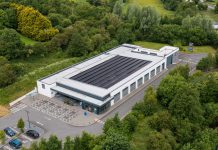Iomart are a leading cloud computing, managed services, and co-location provider who, as part of their global operations, operate 13 Data Centres in the UK, all connected to their own high speed dark fibre network.
As a publicly listed company with over £100m+ in annual revenue and growing, the business demands that its supporting infrastructure is of the highest resiliency while also supporting its ambitious sustainability and environmental goals.
A planned lifecycle upgrade for one of their existing facilities was due and initial design works had been completed to provide the facility with new cooling infrastructure, offering higher efficiencies and a greater level of resiliency for the facility overall.
Sudlows were appointed to deliver the upgrade. Our highly experienced Data Centre Design, Engineering and Construction Teams worked closely with Iomart, their Designers, and their Site Operations Team to ensure the project was completed smoothly with minimal impact to the operations of the live facility and critically, with no downtime.
The project centred around the replacement of 4 No. existing water-cooled chillers, located internally within the building, with 2 No. new central chiller plant systems consisting of a total of 7 No. new Mitsubishi Electric inverter scroll and modular air-cooled water chillers.
Each plant area was to be contained within an acoustic enclosure to ensure that the planning conditions were met, however the design of these within the limited plant space required critical attention to the air flow characteristics to ensure that full capacity operation was maintained at all times.
A model for simulation was produced from the design stage BIM model, with critical features affecting air flow being a focal point for detailed modelling. The surrounding buildings and urban environment were also to be considered from a combination of airborne laser scanned surface data and onsite point clouds to allow for a detailed model to be generated and for assessment of both the local and larger scale air dynamics which may affect the plant operation.
Designed for heat
A key driver for the project was to ensure that full consideration had been given to the air flow required for the proposed chiller plant at peak ambient temperatures. Importantly, doing this during the design stage as opposed to after ensures that any necessary improvements are able to be implemented with minimal cost.
The site’s location in Central London means that there is a large number of surrounding buildings which affect the air flow, and the density of development is known to result in an elevated temperature within the local micro-climate due to heat output from neighbouring buildings and the increased surface area absorbing solar energy. The requirement for an enclosed acoustic enclosure introduces further challenges as it can present a barrier to the fresh air flow required for the heat rejection to operate with stability. Because of these risks and challenges, Computational Fluid Dynamics (CFD) offered the best tool to be able to model the plant, proposed installation, and extreme design conditions to ensure that the equipment remained able to operate without compromise during peak ambient conditions, considerate of the local environment and potential wind and building eddy interactions.
The simulations and the subsequent investigations, analysis and optimisation which were then possible – were a critical part of the design stage and supported the ultimate successful delivery of the project as a whole.
The newly upgraded facility now also benefits from an enhanced cooling infrastructure, and the benefit of knowing that adverse ambient conditions and wind velocities have been considered as part of the design process, and potential issues mitigated wherever possible.
The final model produced by Sudlows was comprehensive and ensured a high degree of accuracy from the output simulations.
Initial results from the first design iteration were found to be unfavourable in a small number of conditions, with recirculation possible between the intake and exhaust sections of the acoustic enclosure. In response to the simulation outcomes, changes were made to the proposed design to mitigate these issues and a subsequent simulation was produced which demonstrated an improved air flow pattern which improved the fresh air supply substantially.
Without such design optimisation, the heat rejection systems would not only have potentially struggled at high temperatures but would also have operated at a lower overall efficiency during lower temperature days. Thanks to this technique, the final solution is not only a highly resilient installation but also a highly efficient solution too, resulting in a tangible ROI on the CFD exercise over and above the additional confidence gained from it.
Zac Potts, Head of Sustainability at Sudlows commented, “This project is a great example of using CFD to ensure that not only is an installation able to perform at peak ambient conditions, but that efficiency in operation has been maximised throughout the year by mitigating the risk of recirculation. The quality of the analysis undertaken by the Simulation and Modelling Team was critical to the overall success of the project.”



